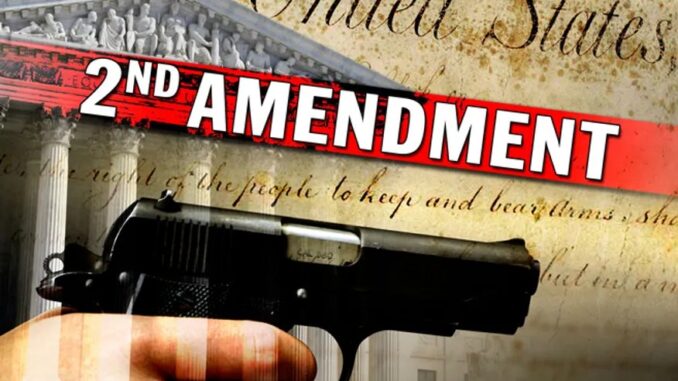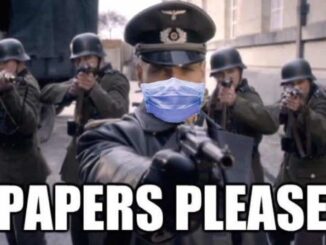
The Second Amendment’s Right to Bear Arms: What It Means
By John W. Whitehead & Nisha Whitehead
“A well regulated militia, being necessary to the security of a free state, the right of the people to keep and bear arms, shall not be infringed.”—The Second Amendment to the US Constitution
You can largely determine where a person will fall in the debate over gun control and the Second Amendment based on their view of government and the role it should play in our lives.
In the first group are those who see the government as a Nanny State, empowered to look out for the best interests of the populace, even when that means overriding our rights as individuals and free will.
These individuals tend to interpret the Second Amendment to mean that only members of law enforcement and the military are entitled to own a gun. Case in point: President Biden recently (and wrongly) asserted that “the Second Amendment, from the day it was passed, limited the type of people who could own a gun and what type of weapon you could own. You couldn’t buy a cannon.”
In the second group are those who see the government as inherently corrupt.
These individuals tend to view the Second Amendment as a means of self-defense, whether that involves defending themselves against threats to their freedoms or threats from individuals looking to harm them. For instance, eleven men were recently arrested for traveling on the interstate with unlicensed guns that were not secured in a case. The group, reportedly associated with a sovereign citizens group, claimed to be traveling from Rhode Island to Maine for militia training.
And then there is a third group, made up of those who view the government as neither good nor evil, but merely a powerful entity that, as Thomas Jefferson recognized, must be bound “down from mischief by the chains of the Constitution.” To this group, the Second Amendment’s assurance of the people’s right to bear arms is no different from any other right enshrined in the Constitution: to be safeguarded, exercised prudently and maintained.
How to exercise this right is the question that keeps jockeying for supremacy before the U.S. Supreme Court. After declaring more than a decade ago that citizens have a Second Amendment right to own a gun in one’s home for self-defense, the Court has now been tasked with deciding whether the Constitution also protects the right to carry a gun outside the home. The case, NY State Rifle & Pistol Assoc. v. Corlett, takes issue with a state law that requires a license in order to carry a concealed gun outside the home.
On the heels of Corlett is another legal challenge to the state’s authority to regulate—or ban outright—gun ownership outside the home. The attorneys general of 21 states have filed an amicus brief in Young v. Hawaii asking the Supreme Court to uphold Hawaiians’ Second Amendment rights to bear arms outside their homes.
Unfortunately, while the various federal circuit courts of appeal continue to disagree over the exact nature of the rights protected by the Second Amendment, the government itself has made its position extremely clear.
When it comes to gun rights in particular, and the rights of the citizenry overall, the U.S. government has adopted a “do what I say, not what I do” mindset. Nowhere is this double standard more evident than in the government’s attempts to arm itself to the teeth, all the while viewing as suspect anyone who dares to legally own a gun, let alone use one in self-defense.
Indeed, while it still technically remains legal to own a firearm in America, possessing one can now get you pulled over, searched, arrested, subjected to all manner of surveillance, treated as a suspect without ever having committed a crime, shot at, and killed. (This same rule does not apply to law enforcement officials, however, who are armed to the hilt and rarely given more than a slap on the wrists for using their weapons against unarmed individuals.)
Ironically, while Americans have to jump through an increasing number of hoops in order to own a gun, the government is arming its own civilian employees to the hilt with guns, ammunition and military-style equipment, authorizing them to make arrests, and training them in military tactics.
This is the double standard at play here.
We’ve allowed ourselves to get so focused on debating who or what is responsible for gun violence—the guns, the gun owners, or our violent culture—and whether the Second Amendment “allows” us to own guns that we’ve overlooked the most important and most consistent theme throughout the Constitution: the fact that it is not merely an enumeration of our rights but was intended to be a clear shackle on the government’s powers.
When considered in the context of prohibitions against the government, the Second Amendment reads as a clear rebuke against any attempt to restrict the citizenry’s gun ownership.
As such, it is as necessary an ingredient for maintaining that tenuous balance between the citizenry and their republic as any of the other amendments in the Bill of Rights, especially the right to freedom of speech, assembly, press, petition, security, and due process.
In other words, the freedoms enshrined in the Bill of Rights in their entirety stand as a bulwark against a police state.
When all is said and done, the debate over gun ownership in America is really a debate over who gets to call the shots and control the game. In other words, it’s that same tug-of-war that keeps getting played out in every confrontation between the government and the citizenry over who gets to be the master and who is relegated to the part of the servant.
In a nutshell, as I make clear in Battlefield America: The War on the American People, the Second Amendment’s right to bear arms reflects not only a concern for one’s personal defense, but serves as a check on the political power of the ruling authorities. It represents an implicit warning against governmental encroachments on one’s freedoms, the warning shot over the bow to discourage any unlawful violations of our persons or property.
As such, it reinforces that necessary balance in the citizen-state relationship.
As George Orwell, who plays a starring role in my new novel The Erik Blair Diaries, noted, “That rifle hanging on the wall of the working-class flat or labourer’s cottage is the symbol of democracy. It is our job to see that it stays there.”

About John W. Whitehead
Constitutional attorney John W. Whitehead is founder and president of The Rutherford Institute and author of Battlefield America: The War on the American People and A Government of Wolves: The Emerging American Police State. He can be contacted at johnw@rutherford.org. Nisha Whitehead is the Executive Director, The Rutherford Institute.
The views, opinions, or positions expressed by the authors and those providing comments are theirs alone, and do not necessarily reflect the views, opinions, positions of Redoubt News. Social Media, including Facebook, has greatly diminished distribution of our content to our readers’ newsfeeds and is instead promoting Main Stream Media sources. This is called ‘Shadow-banning’. Please take a moment and consider sharing this article with your friends and family. Thank you. Please support our coverage of your rights. Donate here: paypal.me/RedoubtNews





